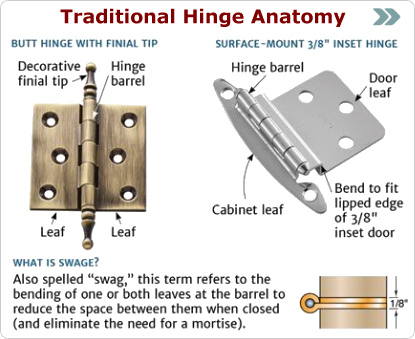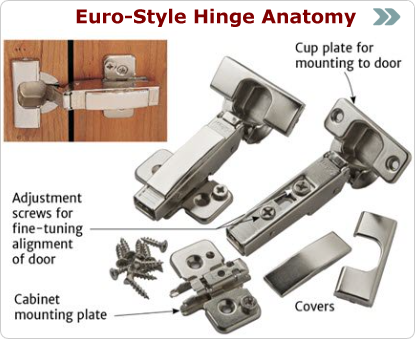🌵 Search azWoodman
▸ A list of common hinges, their uses and descriptions.
↓ ↓ Click on a Term to Jump Down ↓↓ the Page
❈ Hinges: Glossary of Terms for Cabinet Hinges
▸ Terminology to help you understand cabinet hinges and hardware terms.▸ A list of common hinges, their uses and descriptions.
↓ ↓ Click on a Term to Jump Down ↓↓ the Page
|
▸ 0 Clearance ▸ Exposed Hinges ▸ No-Mortise ▸ 270° Hinge ▸ Face Frame ▸ Overlay ▸ ⅜" Inset ▸ Finial Tip ▸ Pin Hinge |
▸ Ball Tip ▸ Frameless ▸ Pivot Hinge ▸ Barrel ▸ Free Swinging ▸ Reverse Bevel ▸ Butt Hinge ▸ Full Overlay ▸ Self Closing |
▸ Clip On ▸ Fully Concealed ▸ Semi-Concealed ▸ Concealed Hinges ▸ Half Overlay ▸ Slip On ▸ Cup ▸ Inset ▸ Snap Closing |
▸ Degree Of Opening ▸ Knife Hinge ▸ Soss Hinge ▸ European Hinges ▸ Lipped ▸ Surface Mounted ▸ Euro Style Cabinets ▸ Mounting Plate ▸ Wrap Around |
|
Ball Tip - An exposed tip of the pin of a butt hinge that is shaped like a ball.
Barrel - The part of butt hinge where the two halves come together and are joined with a pin. Butt Hinge - A hinge composed of two plates attached to abutting surfaces of a door and cabinet and joined by a pin. Clip On - A concealed hinge that allows you to attached the two parts of the hinge together by simply snapping them together. Makes finishing the doors a breeze! Concealed Hinges - This refers to any hinge that does not show from the outside of the cabinet. Cup - This refers to the door portion of a concealed hinge(such as the Blum hinges) that requires a hole to be drilled in the back of the door. The cup portion of the hinge is inserted into this hole. Degree Of Opening - This refers to how far or to what angle a door will open. Some hinges will allow the doors to open farther allowing for better access to the contents of the cabinet. 270 Degree Hinge - This refer to a hinge that allows the door a full movement of 270 degrees which allows it to open all the way to the outside side of the cabinet wall. This can only be achieved on a frameless full overlay cabinet design. European Style Cabinets - Frameless cabinets which use a concealed hinge. European Hinges - Hinges that are concealed and which use a hole bored into the back of the door. Exposed Hinges - Hinges that show on the outside of the cabinet. Hinges that are not concealed or hidden. Face Frame - A cabinet is in essence a box. A face frame is a narrow piece of wood, usually about 2" wide that is attached to the front of this box, framing the opening where the doors go. Finial Tip - An exposed tip of the pin of a butt hinge that has a fancy turned shape. Frameless - A frameless cabinet is one that does not have a face frame. A frameless cabinet is made like a simple four sided box. This is sometimes called European style. Free Swinging - This means the hinge can move freely along its path from open to closed. There is no sort of catch feature to keep the door shut. Fully Concealed - Will not show at all from the outside of the cabinet. Full Overlay - In frameless cabinet construction the box is typically made from 3/4" thick stock. A full overlay will cover the complete front edge or just slightly less than this stock. A full overlay hinge is typically used on the outsides or ends of a cabinet. Half Overlay - In frameless cabinet construction the box is typically made from 3/4 inch thick stock. A half overlay is commonly used in the middle of a run of cabinets where the doors share a common single partition wall. This hinge will allow the door to cover up half of the partition wall (or approximately 3/8"). Not to be confused with 1/2 inch overlay which will allow a door to cover up the cabinet or face frame by 1/2 inch. Inset - A door that sits within the cabinet opening such that the front face of the door is flush with the front of the cabinet or face frame. 3/8 inch Inset - This is a door that has a 3/8" x 3/8" rabbet cut all the way around the door on the back edge. This cut allows half the thickness of the door to go back into the cabinet and leaves the front half of the door overlaying the cabinet or face frame. It is also sometimes called a lipped door. Knife Hinge - Shaped like scissors. One half of hinge mounts to top edge (or bottom edge) of door. Other half mounts to horizontal cabinet member directly above (and below) door. Lipped - This is a door that has a rabbet cut all the way around the door on the back edge. This cut allows part of the door to go back into the cabinet and leaves the remaining part overlaying the cabinet or face frame. Mounting Plate - The part of a concealed european style hinge (such as a Blum hinge) that mounts on to the cabinet or face frame. No-Mortise - A style of hinge that can be mounted directed to the cabinet and the door without any mortises or special cuts being made into the wood surfaces. Overlay - A door which sit in front of the cabinet and covers or overlays a portion of the cabinet or face frame. Pin Hinge - A hinge that pivots on a single point. Offers a very low profile as only the pivoting knuckle is visible from the outside of the cabinet. Pivot Hinge - A concealed hinge for inset doors which uses a bushing placed into the horizontal cabinet members above and below the door, with a pin coming down from the hinge into the bushing. Reverse Bevel - A door edge that is angled backwards allowing the door edge to serve as the pull. This gives a much simpler,cleaner looking design of cabinets. Self Closing - This type hinge will have a design feature to help pull the door shut and keep it closed when the door is brought within a few inches of being closed. Sometimes called snap-closing. Semi-Concealed - This term is applied to a hinge where some of hinge shows on the outside of the cabinet, but a portion of it is hidden behind the door. Slip On - A concealed type hinge where the two parts of the hinge are fastened together by slipping one half on the the other and then tightening a screw. Snap Closing - This type of hinge will have a design feature to help pull the door in and keep it shut when the door is brought within a few inches of being closed. Sometimes called self-closing. Soss Hinge - A specialty concealed hinge used for inset doors. Requires mortises into the door and cabinet for the bodies of both hinge halves. Surface Mounted - A hinge that does not need a hole or mortise drilled in the door or cabinet in order to mount it. In a concealed hinge it simple mounts with screw. In an exposed hinge it also means the entire hinge will show on the outside of the door and cabinet. Wrap Around - A style of hinge where the plates of the hinge are formed around the back edge of the door and/or the face frame. A partial wrap around hinge will wrap around the door and have a plain flat leaf for the cabinet so it can be used on a frameless cabinet. A full back-to-back wrap around hinge with wrap around on both halves of the hinge so it can be used on a face frame cabinet. Zero Clearance - A hinge that allows unobstructed access for pullout shelves or drawer when a door is open to 90 degrees or more. This means that the door will not protrude into the area of the cabinet opening when open. This is only possible in a full overlay door layout. |
📌 azWoodman.com is a participant in the Amazon.com Services LLC Associates Program, an affiliate advertising program designed to provide a means for sites to earn advertising fees by advertising and linking to Amazon.com and affiliated sites.
.

